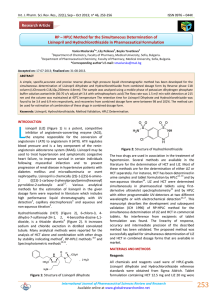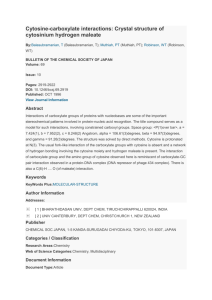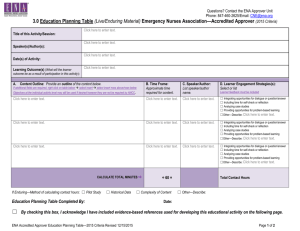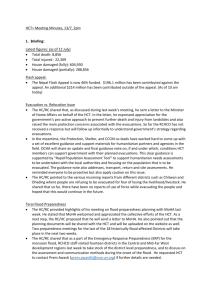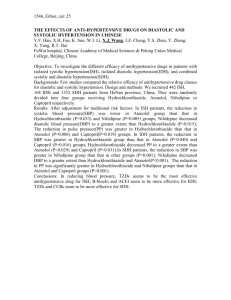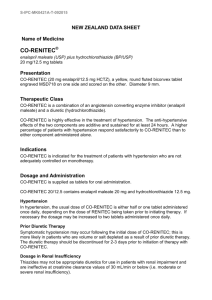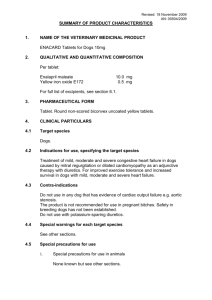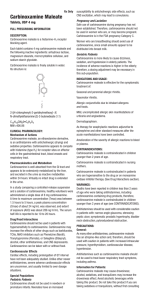a validated rp hplc method for simultaneous estimation of enalapril
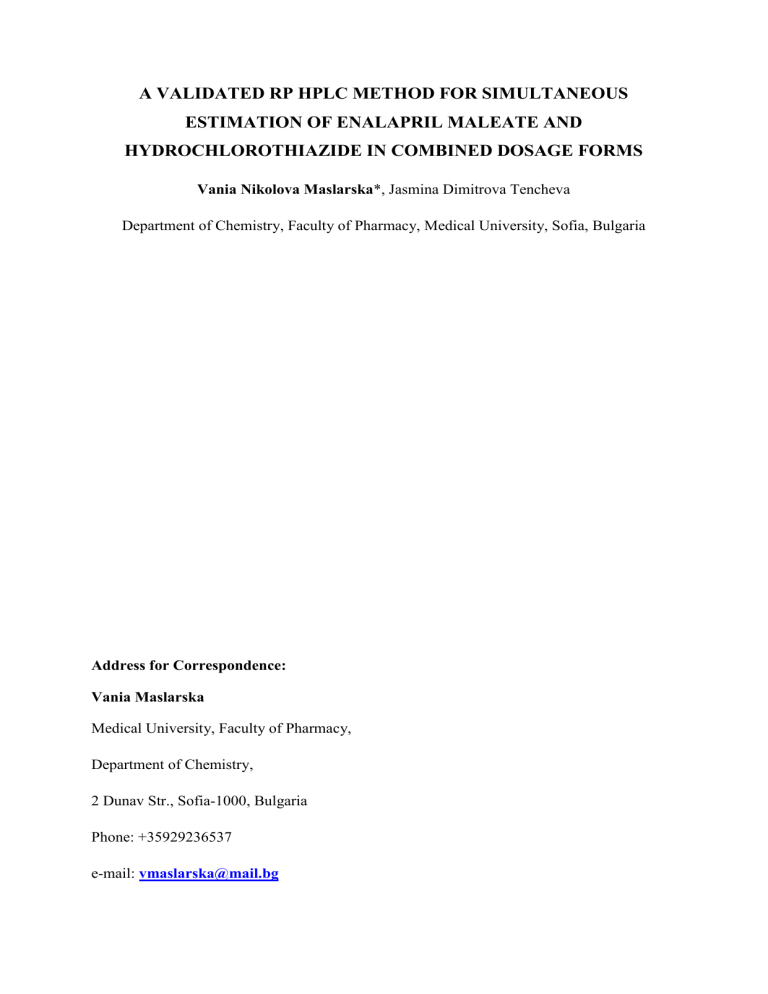
A VALIDATED RP HPLC METHOD FOR SIMULTANEOUS
ESTIMATION OF ENALAPRIL MALEATE AND
HYDROCHLOROTHIAZIDE IN COMBINED DOSAGE FORMS
Vania Nikolova Maslarska *, Jasmina Dimitrova Tencheva
Department of Chemistry, Faculty of Pharmacy, Medical University, Sofia, Bulgaria
Address for Correspondence:
Vania Maslarska
Medical University, Faculty of Pharmacy,
Department of Chemistry,
2 Dunav Str., Sofia-1000, Bulgaria
Phone: +35929236537 e-mail: vmaslarska@mail.bg
ABSTRACT
A new simple, rapid and sensitive reversed-phase liquid chromatographic method was developed and validated for the simultaneous determination of Enalapril maleate (ENA) and
Hydrochlorothiazide (HCT) in their combined dosage form. The analysis was carried out on
LiChrosorb C18 column (250x4.6 mm, 5 µm particle size) using a mobile phase consisting of
Acetonitrile : phosphate buffer (pH=3.4) mixture (25:75 v/v). The mobile phase was pumped at a flow rate 1.5 ml/min with ultraviolet detection at 215 nm and temperature 40 ºC. The selectivity, linearity, accuracy and precision were examined as parts of the method validation.
The concentration response relationship was linear over a concentration range of 0.1-0.8 and
0.06-0.48 µg/ml for ENA and HCT respectively with limits of detection of 12 and 60 ng. The proposed method was applied for the simultaneous determination of the two studied drugs in their combined tablets with average recoveries of 99.87±0.40 % and 100.12±0.68% for ENA and HCT, respectively. Statistical analysis showed that the method is repeatable and selective for the estimation of ENA and HCT.
Key words: Enalapril maleate, Hydrochlorothiazide, RP-HPLC, Validation.
INTRODUCTION
Enalapril maleate (ENA) is competitive inhibitor of angiotensin – converting enzyme (ACE).
ENA is a derivative of 2 amino acids, L-alanine and L-proline, and is an antihypertensive and a vasodilator in congestive heart failure [1]. Chemically, ENA is (S)-1-[N-[1-(ethoxy carbonyl)-3 phenyle propyl]-L- alanyle]- L-proline Maleate (Fig.1).
Fig. 1 Structure of Enalapril maleate
Various analytical methods for the estimation of Enalapril in the given dosage form were reported in literature which includes high performance liquid chromatography with UV detection [2], capillary electrophoresis [3] and flow injection analysis based on the formation of ternary complex [4].
Hydrochlorothiazide (HCT), 6-chloro-3, 4-dihydro-7-sulfamoyl-2H-1, 2, 4-benzothia-diazine-
1,1-dioxide, is a thiazide diuretic [5] (Fig. 2). It increases sodium and chloride excretion in distilled convoluted tubule. Many analytical methods were reported for the analysis of HCT alone and combination with other drugs by stability indicating method [6], RP-HPLC methods [7, 8], and UV- spectrophotometric methods [9, 10].
Fig. 2 Structure of Hydrochlorothiazide
The two drugs are used in association in the treatment of hypertension [11]. Several methods are available in the literature for the determination of HCT and ENA. Most of these methods are for the determination of either ENA or HCT separately. For instance, HCT has been determined in urine samples and tablet formulation by HPLC [12, 13] and by non-aqueous titration [14]. Enalapril maleate and HCT were determined simultaneously in pharmaceutical tablets using first-derivative ultraviolet spectrophotometry, with zero-crossing and peak-to- base measurement methods [15] and by HPLC with either programmable UV-detectors at two different wavelengths or with electrochemical detection [15-16]. This manuscript describes the development and subsequent validation (ICH 1996) of RP-HPLC method for the simultaneous determination of ENA and HCT in commercial tablets. No interference from excepients of tablet formulation was found. The linearity of response, accuracy and intermediate precision of the described method has been validated. The proposed method was successfully applied for simultaneous determination of ENA and HCT in combined dosage forms that are available in market.
MATERIALS AND METHODS
Reagents
All chemicals and reagents used were of HPLC-grade. Enalapril maleate and
Hydrochlorothiazide reference standards were obtained from Sigma Aldrich. Tablet formulation containing HCT 12.5 mg and ENA 20 mg were obtained commercially. HPLC grade Acetonitrile was procured from Merck Ltd. All other chemical reagents were of analytical grade.
Instrumentation
A Shimadzu HPLC system was utilized consisting of the following components: quaternary pump LC – 20 AD, vacuum degasser unit DGU – 20 A
5
and a UV/VIS variable detector SPD
– 20 A. Separation was carried out on a LiChrosorb C 18 column (250 x 4.6 mm, particle size
5 µm) under reversed phase partition chromatographic conditions. The equipment was controlled by a PC installed properly with the chromatographic software.
Chromatographic Conditions
The mobile phase was 25:75 % v/v mixture of Acetonitrile:Phosphate buffer (136 mg potassium dihydrogen phosphate in 1000 ml water, adjusted with orthophosphoric acid, pH=3.4±0.1). The mobile phase was filtered through 0.45 µm membrane filter and degassed by using sonicater for about 10 min before use. The sample solutions were also filtered using
0.45 µm membrane filters. The mobile phase was delivered isocratically at a flow rate 1.5 ml/min. The column was maintained at 40ºC temperature. The injection volume was 20 µl and the total run time was 4 minutes. The detection was carried out at 215 nm.
Preparation of the Standard Solution
Accurately weighed quantity of 40 mg ENA and 25 mg HCT is transferred in 200 ml volumetric flask, dissolved with 50 ml methanol and made up with phosphate buffer having the concentration of 200 μg/ml of ENA and 125 μg/ml of HCT. From the stock solutions further dilutions were prepared by diluting required volume of mobile phase.
Sample preparation
Twenty tablets were accurately weighed (to obtain the average mass of tablets) and finally powdered. Weight equivalent to 40 mg of ENA and 25 mg of HCT (2 tablets) was taken and transferred into a 200 ml volumetric flask. Approximately 50 ml of diluent (pH 3.4 buffer) were added and the mixture was sonicated for 15 minutes. After that 50 ml methanol were added and the mixture was sonicated again for 15 minutes. The mixture was then diluted to volume with phosphate buffer. The solution was then filtered off through a 0.45 μ filter discarding the first few ml of filtrate.
RESULTS AND DISCUSSION
All of the analytical validation parameters for this proposed method were determined according to ICH guidelines as follows:
Selectivity
The placebo solution was prepared by using 187.5 mg of the following excepients: Lactose monohydrate 30%, Maize starch 12%, Sodium Bicarbonate 5%, Sodim starch glicolate 2%,
Mg-stearate 1%, Cellulose 49% and Iron oxide yellow E172, dissolved in 50 ml methanol and sonicated for 15 minutes. The mixture was diluted to volume with phosphate buffer as solvent. The placebo sample was injected twice into system (Figure 3) according to the parameters stated under the developed method. It was found that there is no interference between the analyte and both the solvent and placebo.
Fig.3: Placebo chromatogram
Linearity
The table 1 presents the equation of the regression line, correlation coefficient (r 2 ) values of the slope and intercept for each compound between the peak areas and concentrations of 100-
800 μg/ml with r 2 =0.999, 60-480 μg/ml with r 2 =0.994 for ENA and HCT respectively (Fig.4-
5). For all the two drugs, r
2 ≈1 and the calibration curve equation showed a good linearity curve which means that the linearity test is validated.
Table: 1. Linearity Results, Limit of Detection (LOD) and Limit of Quantification
(LOQ)
Fig.4: Linearity of Enalapril maleate
Fig.5: Linearity of Hydrochlorothiazide
Specificity of the method
The specificity of this method was determined by complete separation of ENA and HCT as shown in Fig. 6. The peaks obtained for ENA and HCT were sharp and have clear baseline separation. The retention time is short for the drugs separation (1-4 min) and no overlapping between peaks obtained.
Fig. 6: Chromatogram of Enalapril maleate and Hydrochlorothiazide
Precision
Table 2 shows the results of the test that obtained by running the samples in two days by using different analyst. In second day, the same chromatographic conditions applied and the concentration was 100 %. Assay % and RSD % values obtained are within range 98 %- 102
% (±2), which indicate a valid method. These precision tests were applied for the two drugs and the data observed showed a precise and valid method of analysis.
Table: 2. Results of Intermediate Precision
Accuracy
The accuracy test was applied in different levels of concentrations for the two drugs in one sample solution with triple injections for each sample (Tables: 3-4). The % of recovery equation is:
% Accuracy = [(recovered amount / actual amount) X 100]
The accepted limits of recovery are 98 %-102 % according to USP and all observed data are within the required range that indicates good recovery values.
Table: 3. Accuracy of Enalapril maleate
Table: 4. Accuracy of Hydrochlorothiazide
CONCLUSION
An accurate, sensitive and precise HPLC method with ultra violet detection was developed and fully validated for quality control analysis of ENA and HCT in their combined tablets.
The proposed method is very rapid, where the total analytical run time for both drugs is less than 4 min.
REFERENCES
1.
Goodman and Gillman’s. The Pharmacological Basis of Therapeutics. 11 th
Edn.,
McGraw Hill Medical Publishing Division, New York, 2005, 802.
2.
Hassan Y, Aboul E, Laila I, Pharmacokinetic Parameters and Relative Bioavailability of Two Tablet Formulations of Enalapril Maleate, Instrumentation Science &
Technology, 2005, 33 (1), 1-8.
3.
Qin X, Dominic E, Tsai E, Determination and rotamer separation of enalapril maleate by capillary electrophoresis, J Chromatogr A , 1992, 626 (2), 251-258.
4.
Ayad M, Shalaby A, Abdellatef H, Hosny M, Spectrophotometric and AAS determination of ramipril and enalapril through ternary complex formation, J.
Pharmac. Biomed. Anal., 2002, 28 (2), 311-321.
5.
Budavari S, The Merck Index. 14 th
Edn. Whitehouse Station, NJ: Merck Research Lab,
Division of Merck & Co. Inc., USA, 2006, 827.
6.
Daniels SL, Vanderwielen AJ, Stability
‐
Indicating Assay for Hydrochlorothiazide, J.
Pharm. Sci, 2006, 70 (2), 211-215.
7.
Tian D, Tian X, Tian T, Wang Z, Mo F, Simultaneous Determination of Valsartan and
Hydrochlorothiazide in Tablets by RP-HPLC, Indian J. Pharm. Sci ., 2008, 70 (3), 372-
374.
8.
Baing MM, Vaidya VV, Sane RT, Menon SN, Dalvi K, Simultaneous RP-LC
Determination of Losartan Potassium, Ramipril, and Hydrochlorothiazide in
Pharmaceutical Preparations , Chromatographia , 2006, 64 (5), 293-296.
9.
Bhusari KP, Khedekar PB, Seema D, Banode VS, Derivative and Q-analysis
Spectrophotometric Methods for Estimation of Hydrochlorothiazide and Olmesartan
Medoxomil in Tablets, Indian J. Pharm. Sci ., 2009, 71 (5), 505-508.
10.
Stolarczyk M, Masalanka A, Krzek J, Milczarek J, Application of derivative
Spectrophotometry for Determination of Enalapril, Hydrochlorothiazide and Valsartan in Complex Pharmaceutical Preparations, Acta Poloniae Pharm. Drug Res.
, 2008, 65
(3), 275-281.
11.
Sassano P, Chatellier G, Billand E, Corvol P, Monard J, J. Cardiovasc. Pharmacol.
,
1989, 13 (2), 314-319.
12.
Dervies JX, Voss A, Biomedical Chromatog., 1993, 7, 1, 12-17.
13.
Hitscherich ME, Dimitri EM, Tsilifonis C, Daly RE, Simultaneous Determination of
Hydrochlorothiazide and Propranolol Hydrochloride in Tablets by High-Performance
Liquid Chromatography J. Liquid Chromatogr, 1987, 10 (5), 1011-1021.
14.
Honigber IL, Stewart JT, Smith AP, Hester DW, J. Pharm. Sci., 1975, 64, 1201-1206.
15.
Carlucci EG, Giuseppe ED, Mazzeo Y., Simultaneous determination of enalapril maleate and hydrochlorothiazide in tablets by derivative UV spectrophotometry and high-performance liquid chromatography, Inter.
J. of Pharm, 1993, 93, (1-3), 245-248.
16.
Elwalily AF, Belal SF, Heaba EA, Elkersh A, Simultaneous determination of enalapril maleate and hydrochlorothiazide by first-derivative ultraviolet spectrophotometry and high-performance liquid chromatography, J. of Pharm. and Biomedical Analysis, 1995,
13 (7), 851-855.
TABLES AND FIGURES
Fig. 1 Structure of Enalapril maleate
Fig. 2 Structure of Hydrochlorothiazide
Fig.3: Placebo chromatogram
16000000
14000000
12000000
10000000
8000000
6000000
4000000
2000000
0
-2000000
0.0
0.2
0.4
[C, g/ml]
0.6
Fig.4: Linearity of Enalapril maleate
0.8
2500000
2000000
1500000
1000000
500000
0
0.0
0.1
0.2
[C, g/ml
0.3
0.4
0.5
Fig.5: Linearity of Hydrochlorothiazide
Sample #
1
2
3
4
5
6
Average
RSD %
Fig. 6: Chromatogram of Enalapril maleate and Hydrochlorothiazide
Table: 1. Linearity Results, Limit of Detection (LOD) and Limit of Quantification
(LOQ)
Compounds
Enalapril maleate
Hydrochlorothiazide r 2
0.999
0.994
Calibration curve equation
Y=18595148-35460X
Y=4776007-1951X
LOQ ng
25
125
LOD ng
12
60
Table: 2. Results of Intermediate Precision
Assay %
Enalapril maleate
100.9
99.15
98.75
100.1
100.6
100.1
99.93
3
0.831
Hydrochlorothiazide
100.6
98.83
98.44
99.76
100.4
99.65
99.61
0.852
Table: 3. Accuracy of Enalapril maleate
Parameters
Mean X
SD
% RSD
Mean X
SD
% RSD
% Taken
50.00
100.0
150.0
Mass taken
(mg/1 tabl.)
10.25
10.25
10.25
20.50
20.50
20.50
30.75
30.75
30.75
Table: 4. Accuracy of Hydrochlorothiazide
Parameters % Taken
50.00
100.0
150.0
Mass taken
(mg/1 tabl.)
6.3
12.7
19.0
Mass found
(mg/1 tabl.)
10.21
10.15
10.28
20.43
20.57
20.50
30.73
30.79
30.66
% Found
Mass found
(mg/1 tabl.)
6.30
6.11
6.40
12.60
12.70
12.80
18.87
19.02
19.10
% Found
50.00
48.18
50.53
99.37
100.0
100.4
148.6
149.8
150.4
49.81
49.53
50.15
99.65
100.3
100.0
150.2
150.2
149.6
%
Recovery
99.62
99.06
100.3
99.65
100.3
100.0
100.1
100.1
99.72
99.87
±0.400
0.401
%
Recovery
100.0
99.89
101.6
99.37
100.0
100.4
99.32
100.0
100.5
100.1
±0.681
0.680
